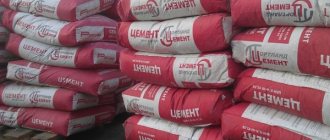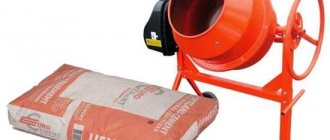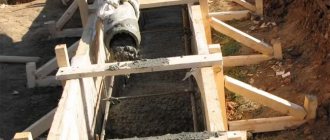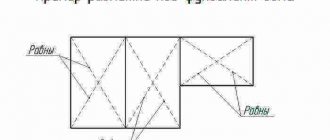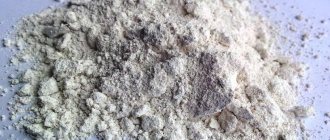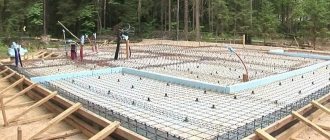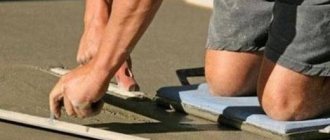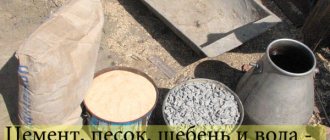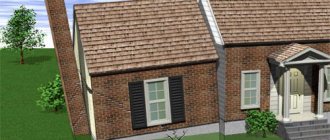Liquid concrete composition is a type of binder aqueous solution with a set of components combined in clear proportions. When hardened, it becomes as strong and reliable as possible with increased resistance to mechanical stress and other negative environmental factors. The stone-like structure withstands critical changes and aggressive influences from the outside, holding buildings of various types for many years.
Professional craftsmen mix concrete compositions without purchasing ready-made mixtures when construction is carried out. To prepare a high-quality consistency and determine financial costs, you need to know the exact volume of cement used per 1 cubic meter of concrete mixture. There is a special system by which calculations are carried out taking into account a variety of factors. Let's consider it and alternative approaches to solving this issue.
Filling materials: sand and granite
Universal auxiliary components, interacting with cement, make it possible to obtain a durable building. Regardless of the brand and type of dry product, the composition of the concrete mass includes:
- crushed stone is a durable frost-resistant stone without harmful impurities and components. To increase the hardness of the concrete mixture, granite is used, with fractions from 10 to 40 mm. Good performance properties determine the high cost and popularity of the building material.
- Sand is a sedimentary solid. A correctly selected brand of sand helps reduce the consumption of expensive limestone. For foundations, alluvial quarry sand of medium grain size from 1.2 mm to 3.5 mm is in demand. The permissible amount of impurities should not exceed 5% of the total volume of sand.
Water is added to the solution in portions until a mixture of homogeneous consistency is obtained. When mixing the constituent elements, be sure to correctly determine their proportions. The resulting voids between grains of gravel if filled incorrectly will subject the base to rapid deformation.
General information about cement-based mortars
It is very important for a novice builder to learn the “recipe” for preparing the most “common” solutions. Under no circumstances should he listen to pseudo-“experienced” advisers who convince him that it is quite possible to do everything “by eye”, the main thing is not to skimp on cement.
With such an amateurish approach, you can go to several extremes at once. For example, the end result will be a composition whose operational capabilities will simply remain unclaimed. Excess cement is a completely unnecessary expense, since it is the most expensive of all the ingredients. And finally, exceeding the proportion of cement compared to other components of the solution often has a negative effect. In finished concrete, which is a conglomerate of components of different compositions, a certain “harmony” must still be achieved, otherwise those strong bonds for which this material is famous will not arise between them.
Preparing a mortar with cement simply “by inspiration,” or as they say, “by eye,” can easily lead to various unnecessary extremes.
What should we do then? How to choose the optimal proportions for preparing a solution for a particular purpose?
There is no need to worry too much about this. There is a special document in which all issues relating to the preparation of mortars and their use are described in meticulous detail. We are talking about the Code of Rules for design and construction SP 82-101-98. The name speaks for itself: “Preparation and use of building mortars.”
The preparation and use of mortars is regulated by this document.
The document contains a lot of information, but most of it is intended for specialists in the field of construction, and it may not be sufficiently clear to beginners taking their first steps in this field. Therefore, while leaving in force the recommendation to still find and carefully study this Code of Rules, we will structure our presentation somewhat differently.
In order not to go into too much detail, first we will consider general tables of proportions of cement-based solutions. Well, then – let’s talk in more detail about several “recipes” that are most popular in individual construction. We will talk about concrete for foundation work, for pouring screed (including insulated screed), for laying brick walls and for plastering such walls.
So, any mortar consists of a binder and filler.
- Since we are talking about cement compositions, then, of course, it is cement that acts as a binder. More precisely, in individual construction, as a rule, Portland cements based on calcium silicates - alites are used. Cement differs in strength grades, and most often M400 (PTs400) or, less commonly, M500 (PTs500) is used.
“Four hundredth” is rightfully considered the best option based on a set of evaluation criteria - availability, cost, quality, and performance indicators.
Fillers may vary. In most concretes, which are expected to have high strength and resistance to mechanical loads, mineral fillers are used - sand, crushed stone, gravel, etc., together or separately (sand is pumped). But other materials can also be used as filler, primarily insulation materials, in order to lighten the structure being poured and give it thermal insulation qualities. We are talking about expanded clay, vermiculite, perlite, foamed granular polystyrene or foam glass, etc. And to increase resistance to mechanical loads and cracking, reinforcing fibers can be added to concrete, for example, polypropylene, metal, fiberglass or asbestos fiber.
Mixing concrete with the addition of polypropylene fiber
The launch of the necessary hydration reaction with the formation and maturation of cement stone occurs as a result of mixing the mixture of ingredients with ordinary clean water (this applies specifically to Portland cement, since other varieties may require a different liquid filling). The amount of water cannot be arbitrary - the optimal water-cement ratio must be ensured.
For those who may not be aware, the amount of water added to the cement mortar also obeys certain rules.
In addition to water, special additives can be added to the solution at the stage of its preparation, increasing the plasticity of the mixture, improving its adhesive abilities, accelerating the process of setting and gaining primary strength. It is interesting that amateur builders often consider liquid detergents as one of these plasticizing additives. But whether they are really able to help in this matter, if you know how to use them correctly, or whether their use also has a negative side, is a moot point.
By the way, slaked lime becomes an excellent plasticizer for cement mortar if it is added in reasonable proportions established by the rules.
Concrete and mortars produced on the basis of cement may, after full maturation, have different grade strengths, designated by the letter “M” and some number from 10 and higher. this indicator is the value of the permissible load, expressed in kgf/cm².
Often, recently, designations have begun to appear not by strength grade, but by class.
The class is designated by the letter “B” and a number. This number is also the permissible load, but only, firstly, expressed in megapascals. And secondly, this is not an average value, like the brand, but guaranteed strength, no less than 95% of cases.
The parameters are similar, but still have differences. To see the relationship between them, you can use the following table:
| Solution class | Brand of solution |
| V 3.5 | M 50 |
| AT 5 | M 75 |
| B 7.5 | M 100 |
| AT 10 | M 150 |
| At 12.5 | M 150 |
| At 15 | M 200 |
| IN 20 | M 250 |
| At 22.5 | M 300 |
| At 25 | M 350 |
| At 27.5 | M 350 |
| At 30 | M 400 |
| At 35 | M 450 |
| At 40 | M 550 |
| At 45 | M 600 |
| At 50 | M 700 |
| At 55 | M 750 |
| At 60 | M 800 |
| At 65 | M 900 |
| At 70 | M 900 |
| At 75 | M 1000 |
| At 80 | M 1000 |
From the same starting components you can get solutions of different brands - it's all a matter of mixing proportions. These are the proportions we will consider further for the most popular types of concrete and mortars.
How to calculate cement for a foundation
The method for calculating the required amount of cement is quite simple. The main role, naturally, is given to concrete, which is planned to be obtained from this building material. Having studied the proportions of concrete for the foundation, it is easy to calculate how much cement will be needed to build the foundation of the house. Calculations are usually carried out in bags that can contain kg of binder.
Approximately how much cement will be needed to build a foundation?
The calculation sequence can be presented as follows, step by step:
- First, we calculate the volume of concrete that will be used to build the foundation. We wrote how to do this in the article “Calculation of concrete for a foundation.” At this stage, it all comes down to summing up the volumes of individual foundation structures, or the usual volume calculation, which is important for a slab foundation;
- Next, we determine the composition of the concrete mass. Depending on the loads on the sub-foundation of the house, as well as the composition of the soil, the grade of concrete is determined. The percentage of cement per unit volume (usually calculated per cubic meter) depends on the brand of concrete mixture. At the same time, an analysis is carried out to determine whether it is necessary to introduce various additives into concrete to simplify the work under specific conditions;
- at the last stage, the required amount of binder and fillers (sand, crushed stone, etc.) is calculated. We will talk about what kind of sand is needed for the foundation in one of the following articles.
Below we have presented a table, using which you can calculate the approximate number of bags of cement per concrete for the foundation. Minor adjustments are possible both up and down. If you plan to strengthen the foundations with cementation (we are mostly talking about restoring the old foundation, when a new one is additionally attached to it), then, accordingly, the volume of required cement must be adjusted to the cement mortar, and not the concrete mixture.
Design grade of concrete Brand of cement used Approximate mass of cement per 1 cubic meter. m of concrete Number of bags 50 kg per 1 cubic meter m. concrete, pcs.
| M150 | M300 | 260 | 5,2 |
| M200 | M300 | 290 | 5,8 |
| M400 | 250 | 5 | |
| M500 | 220 | 5,4 | |
| M250 | M300 | 340 | 6,8 |
| M400 | 300 | 6 | |
| M500 | 250 | 5 | |
| M300 | M400 | 350 | 7 |
| M500 | 300 | 6 | |
| M400 | M400 | 400 | 8 |
| M500 | 330 | 6,6 |
It turns out that calculating the volume of cement for the foundation is not particularly difficult
It is only important to know the volume of concrete required for the construction of a specific type of house foundation, as well as the ratio of the components included in the concrete mixture
Calculation of cement consumption
Construction work must begin with calculations and estimates. You cannot lay a foundation without a clear understanding of how much cement is needed and what costs await you. Even at the initial design stage, you will have to calculate the need for the main components of the structure.
Correct costing will allow you to avoid costs associated with excessive consumption of materials, as well as downtime caused by their shortage. You need to calculate all the moments, and you need to do this in advance, before you get to work.
If you are planning to build a foundation for a country house or residential building in the near future, take the trouble to carefully calculate the need for cement to prepare the concrete mass. Today there are several ways to create estimates, the simplest of which is to use an electronic calculator.
Many websites offer such a service. By entering the initial data, the calculator will calculate the need for materials in a matter of seconds. To get the long-awaited quantity result, you need to know the following indicators:
- required volume of solution;
- brand of cement used.
Approximate tabular data
The approximate consumption of cement per cube of concrete for the foundation, depending on the brand used, is presented in the tables:
mixture prepared on the basis of M300
| Concrete grade | M250 | M300 |
| Required mass of cement, kg | 340 | 300 |
based on M400
| Concrete grade | M300 | M400 |
| Required mass of cement, kg | 350 | 300 |
When the amount of cement of a particular brand in the composition changes, the brand of concrete changes. The values indicated in the table depend on the quality of the soil and the size of the crushed stone material, and therefore may change up or down during calculations.
Does it make sense to use M500 for the foundation?
Using the arithmetic method or tables, it is not difficult to find out, for example, how much M 500 cement is needed per 1 cubic meter of concrete for the foundation. At least 8 bags or 400 kg to obtain M400 mortar, used for the construction of foundations in professional construction.
Using M500 in small construction does not make sense
It is not advisable for 1 cubic meter of concrete to contain more than 350 kg of cement. An oversaturated foundation will be subject to severe cracking after the final evaporation of moisture. Therefore, it is not advisable to use the M500 grade for placing concrete under the foundation. This material is intended for other purposes.
What is the foundation made of?
A monolithic concrete foundation is prepared from a solution of parts of cement, crushed stone or gravel, sand and water. Foundation cement is the main component. Additional materials, but not the least, are sand and gravel. Taken in certain proportions that must be adhered to, they constitute the solution for construction needs.
Gravel, sand
It is advisable to take the components for the concrete mixture in certain sizes. So it is better to use sand up to 3 mm in diameter.
In addition, the material must be chosen clean, without silt, clay and other particles.
Dirty sand can significantly reduce the quality of the solution and, as a result, the strength of the foundation. The presence of unwanted impurities is acceptable, but only five percent of the total mass of sand.
It is good to use gravel for mixing in different sizes: from 12 millimeters to 85. Small particles of gravel fit into the voids between large granules. They fill the free space among large pebbles. This measure reduces sand consumption. Gravel can be replaced with crushed stone. Its proportions when mixing concrete are the same as for gravel.
Cement and its varietal characteristics
Several brands of cement are known:
- Portland cement is the most popular type of material. It is known in construction for its price and strength characteristics.
- Rapid-hardening Portland cement - it contains special substances designed to increase the rate of hardening of the mixture.
- Portland pozzolanic cement.
- Portland slag cement - slag components are added to the cement base for strength.
The basis of all these types of cement is identical, but each type has special qualitative characteristics, which contain various additives and hence the cost of the material.
In private construction, Portland cement is usually used. It is of good quality and low cost; it is produced without any additives, but if necessary, it can be strengthened by adding appropriate components.
How to calculate cement for a foundation?
To calculate the required mass of cement for the foundation, you need to calculate the total area of the concrete base, and for the base, take the cement consumption per cubic meter.
For a larger number of cement brands, there are already certain data, which are taken as the main measure when building a foundation:
- Cement M 100 is used for pouring concrete foundations on a non-industrial scale. It is suitable in construction for priming floors, used as a base material for concrete road surfaces, etc. For one cubic meter of foundation, 220 kg of cement is taken.
- Brand M200. Cement with excellent strength characteristics. Used for the construction of a support base, construction of industrial structures, etc. 280 kg will be used per cube.
- M 250 - used when pouring foundations, including the bases of fences, stairs, etc. Cement consumption - 330 cubic meters.
- M 300 - building material is in particular demand in individual construction, laying roads, building blind areas, etc. You need to take 380 kg per cubic meter.
Materials calculation: without reinventing the wheel
How to calculate cement for the foundation? For the accuracy of the results, it is necessary to take into account the grades of concrete and cement, as well as the ratio of water and cement, which is called briefly - VC. The table below is visual and does not require a person to have a degree in mathematics.
The table is easy to use. For example, we need to prepare 2 m3 of M250 concrete:
- It requires M500 cement, which means we multiply 297 kg by 2 and get 594 kg. Now this number must be divided by 50, since this is the weight of one bag of cement: 594/50 = 11.88. We round the result towards a larger value - we get 12 bags of M500 cement.
- Crushed stone with a grain size of 20 mm for our concrete will be calculated as follows: 1188 multiplied by 2, we get 2376 kg. If you choose a different faction, then all calculations will have to be done again.
- Sand is calculated in the same way as crushed stone: 1188 * 2 = 2376 kg.
- We find water like this: multiply 205 liters by 2, resulting in 410 liters.
Indeed, calculations should not cause difficulties; you just need to decide on the required characteristics of your raw materials. If plasticizers are used for the foundation, then adjustments must be made to the calculations; the coefficients can easily be found in reference books.
General recommendations
- First of all, try preparing a test portion of the solution. Only through experimentation can you achieve the ideal consistency.
- A good quality cement mortar will only stick slightly to the paddle. If the mixture does not stick, then the solution is thin. In this case, it is necessary to add cement to it. If the mixture sticks too much, it is a greasy solution. Sand should be added to it.
- If the product has been stored for a long enough time before use (5–6 months), it has already lost some of its astringent properties. In this case, its share in the solution should be increased.
- The strength of the solution is also affected by the quality of the sand. Sand of medium fraction is best suited. When using fine sand, cement consumption increases.
- Before mixing the solution, all bulk elements must be carefully sifted through a sieve.
- To check the accuracy of the calculations, you can weigh a cubic meter of concrete. Its weight should be 2.4 kg.
- It’s better not to take materials back to back, since it’s completely inconvenient to run out in the middle of work to buy materials that have suddenly run out.
- When making any calculations, data should be rounded up.
Calculation of cement per 1 cubic meter of concrete (m³)
The proportional ratio of cement to other binding materials affects the mobility of the concrete mixture. In order to prepare high-quality building materials, the following ratios should be adhered to:
- cement up to 1 kg;
- sand up to 3 kg;
- crushed stone up to 5 kg.
Failure to comply with all component ratios leads to a decrease in the strength characteristics of the future building coating. This will lead to rapid wear and cracking of the surface. The quantitative consumption of cement per 1 m³ of solution directly depends on the brand of concrete mixture planned by the manufacturer. Under different climatic conditions and construction zones, different grades of material are used.
Concrete marking classifier
Table of the ratio of classes and grades of concrete.
For various requirements for the stability and reliability of a construction project, the following marking classifier of concrete mixtures is mainly used:
- M100. It is used at the initial (preparatory) stage of construction work.
- M200. Has a wider range of applications. Most often used when filling foundation surfaces.
- M300. This building material has great strength characteristics. The foundation laying with such a concrete monolith is used in industrial construction.
- M400. It is used in the construction of hydraulic structures. It has high strength and differs from other types of concrete by its rapid hardening.
Decoding of the building material: the letter M with a number that indicates the arithmetic mean value of the strength characteristics of the sample, for compression in kgf/cm².
How many cubes of concrete are needed for the foundation?
When constructing a civil or industrial facility, two types of foundation coverings are used: strip and slab foundations. For the convenience of calculation indicators, a reinforced concrete (reinforced concrete) foundation of 10 by 10 is taken:
- Strip foundation. The required amount of construction mixture is determined by the total volume of the base. The calculation is carried out by multiplying metric values: height, length and width of reinforced concrete tape. Initial data: height - 1.5 m, width - 0.5 m, total length of the tape - 55 m. Multiplying the values and rounding the value to a whole number, we get 41 cubic meters of concrete.
- Slab base. The amount of concrete mixture is determined very simply for a slab foundation. For example, the thickness of the slab is 40 cm. Multiplying the initial data, we get: 10 m x 10 m x 0.4 m = 40 m³.
Weight of 1 m³ of concrete mixture
The specific gravity of the binding building material is a variable value.
The mass of concrete weighs differently, depending on its structural components, that is, on the type of aggregate. In civil and industrial construction, a heavy type of concrete monolith is usually used. Gravel and crushed stone of large fractions are used as filler. Thanks to this base, the foundation coating has a particularly durable and stable surface. The weight of one cubic meter of concrete mixture ranges from 1.7 to 2.5 tons.
Types of foundations
- tape;
- in the form of a monolithic slab;
- columnar.
The belt-type structure consists of a continuous shaft made of concrete with iron reinforcement, located along the perimeter of the building and under the load-bearing bulkheads. If the developer needs to determine how much concrete is needed for the foundation, then the dimensions of the structure should be calculated. When measuring the height, the part of the base located deep in the ground is taken into account, and additional blind areas and support platforms are also taken into account (for example, for installing a porch).
To ensure the strength characteristics of the foundation for houses measuring 6 by 8 m, it is necessary to use a foundation strip with a width of 300 mm (100-150 mm wider than future walls), which protrudes 400-450 mm above the ground surface. The depth of occurrence depends on the strength of the soil, climatic conditions and the availability of groundwater.
The monolithic slab located under the building is constructed of concrete grade no lower than M100. To increase strength, reinforcement is placed in the body of the structure; it is possible to use stiffening ribs (directed towards the ground or floor of the room). The beams have a cross-section in the form of a rectangle or an isosceles trapezoid; the arrangement of elements in the longitudinal and transverse directions is allowed. When using trapezoidal ribs, it is recommended to maintain a base length ratio of 1.5/1.
We determine how much cement, sand, crushed stone and water are in a cube of concrete.
4 June, 2013 - 12:35 Concrete is one of the most popular materials in construction. Such popularity of concrete is explained by its excellent properties: compressive strength, ease of molding and laying, waterproofness, water resistance, and low price.
To make concrete, cement, water and so-called aggregates are used, which can be large (crushed stone) or small (sand). Builders often face the question of how to mix concrete correctly. It is at this stage that you usually need to decide how much cement is in a cube of concrete.
Today, there are a large number of grades of concrete that differ in their composition, or more precisely, in the volumetric or mass ratio of the components included in its composition. For example, to create 1 cubic meter of concrete grade 100 requires 200 kg of cement, to create 1 cubic meter of concrete grade 400 requires 360 kg of cement.
There are special tables from which you can understand not only how much cement per cube of concrete is required, but also the percentage of other concrete components in the finished composition.
So, for example, for the most popular concrete grade 300, it is necessary to mix 382 kg of M400 cement, 705 kg of sand, 1080 kg of crushed stone and 220 liters of water. For grade 100 concrete you will need 214 kg of cement (M400), 870 kg of sand, 1080 kg of crushed stone and 210 liters of water.
In general terms, you can determine how much sand is in a cube of concrete using the following scheme:
For 1 volume fraction of cement in concrete grade 100 there are 4.1 fractions of sand and 6.1 fractions of crushed stone; for concrete grade 150, the ratio of cement (M400), sand and crushed stone is 1 to 3.2 and to 5.0; for concrete M200 - 1 to 2.5 and to 4.2; for M250 – 1 to 1.9 and to 3.4 (cement: sand: crushed stone); for 300 1 to 1.7 and to 3,”; for 340 1 to 1.1 and to 2.4.
Table 1. Proportions of cement, sand and crushed stone by concrete grade
| Concrete grade | proportions cement: sand: crushed stone | |
| cement grade 400 | cement grade 500 | |
| 100 | 1,0 : 4,1 : 6,1 | 1,0 : 5,3 : 7,1 |
| 150 | 1,0 : 3,2 : 5,0 | 1,0 : 4,0 : 5,8 |
| 200 | 1,0 : 2,5 : 4,2 | 1,0 : 3,2 : 4,9 |
| 250 | 1,0 : 1,9 : 3,4 | 1,0 : 2,4 : 3,9 |
| 300 | 1,0 : 1,7 : 3,2 | 1,0 : 2,2 : 3,7 |
| 400 | 1,0 : 1,1 : 2,4 | 1,0 : 1,4 : 2,8 |
| 450 | 1,0 : 1,0 : 2,2 | 1,0 : 1,2 : 2,5 |
Knowing these proportions, you can not only easily find out, for example, how much crushed stone is in a cube of concrete, but also mix absolutely any amount of high-quality concrete without much difficulty.
Table 2. Relationships between classes and grades of concrete by strength.
| Brand | Class | Strength, kg/cm2 |
| M-100 | B7.5 | 98,2 |
| M-150 | AT 10 | 131,0 |
| M-150 | B12.5 | 163,7 |
| M-200 | B15 | 196,5 |
| M-250 | B20 | 261,9 |
| M-350 | B25 | 327,4 |
| M-400 | B30 | 392,9 |
| M-450 | B35 | 458,4 |
| M-500 | B40 | 532,9 |
It is important to note that the grade of cement used to make concrete will determine its physical and mechanical properties. So, if instead of M400 cement you add M500 cement, the grade of concrete will increase (say, instead of 200 it will become 350)
In order to get good concrete, you should choose crushed stone, the grade of which will exceed the grade of concrete that we want to get by 2 times.
A simple concrete mixing scheme
If for construction you do not require factory precision, and there is no need to strictly maintain the grade of concrete, you can use a simplified scheme: for 1 part cement, take 0.5 parts water, 2 parts sand and 4 parts crushed stone. To produce 1 cubic meter of concrete, the weight fractions of the components at this ratio will be as follows: cement - 330 kg (0.25 cubic meters), water 180 liters (0.18 cubic meters), sand 600 kg (0.43 cubic meters), crushed stone 1, 25 tons (0.9 cubic meters).
How much cement, sand, gravel (crushed stone) and water is needed to get a cube of concrete:
Concrete M50
- Portland cement M400 - 380 kg. (1)
- Gravel - 608 kg. (1.59)
- Sand - 645 kg. (1.69)
- Water - 210 l. (0.55)
Concrete M75
- Portland cement M300 - 175 kg. (1)
- Crushed stone - 1053 kg. (6.02)
- Sand - 945 kg. (5.4)
- Water - 210 l.(1.2)
Concrete M100
- Portland cement M300 - 214 kg. (1)
- Crushed stone - 1080 kg. (5.05)
- Sand - 870 kg. (4.07)
- Water - 210 l. (0.98)
Concrete M150
- Portland cement M400 - 235 kg. (1)
- Crushed stone - 1080 kg. (4.6)
- Sand - 855 kg. (3.64)
- Water - 210 l. (0.89)
Concrete M200
- Portland cement M400 - 286 kg. (1)
- Crushed stone - 1080 kg. (3.78)
- Sand - 795 kg. (2.78)
- Water - 210 l. (0.74)
Concrete M250
- Portland cement M400 - 332 kg. (1)
- Crushed stone - 1080 kg. (3.25)
- Sand - 750 kg. (2.26)
- Water - 215 l. (0.65)
Concrete M300
- Portland cement M400 - 382 kg. (1)
- Crushed stone - 1080 kg. (2.83)
- Sand - 705 kg. (1.85)
- Water - 220 l. (0.58)
Concrete M350
- Portland cement M400 - 428 kg. (1)
- Crushed stone - 1080 kg. (2.5)
- Sand - 660 kg. (1.54)
- Water - 220 l. (0.51)
ps The sequence of placing materials into a concrete mixer affects the quality of concrete.
Number of bags of cement to prepare 1 cube of solution
Popular packaging of cement is bags weighing 50 kg, which makes it easier to calculate the required amount of material.
The main factor in the calculations is the brand of cement, since each has its own characteristics. The amount of cement is determined by its index, with an increase in which the consumption of material per cubic meter of concrete decreases. Previously, we wrote in detail about which cement is best to use for the foundation.
To determine how many bags of cement are needed to prepare a cube of concrete, you can use a special table. It indicates the amount of cement in liters and kilograms for a certain brand of concrete.
According to the data from this table, 160-200 kg of cement is required for mixing M100 grade concrete, which is used for pouring structures with light loads. If you transfer this mass into 50 kg bags, you get 3.5-4 bags.
For general construction work and for the construction of small buildings, concrete grade M150 is used. To prepare it you will need 200-220 kg of cement, that is, 4-4.5 bags.
It is recommended to pour the foundation and build buildings using M200 concrete. It contains 240-280 kg of cement or 5-6 bags.
Concrete M250 has higher strength characteristics, so it is used when pouring monolithic foundations and staircases. Consequently, it contains a larger amount of cement, 300-330 kg, which corresponds to 6-6.5 bags.
Calculation of materials for concrete
Before starting construction, every developer always asks the question: how many raw materials will be required for the final product and how to determine this?
It's easy to calculate consumption. For example, if to prepare one cube of the finished binder product, 325 kg is required, and the CV is 0.63, then 325 * 0.63 = 205 liters of water are needed. And there is no need to “reinvent the wheel” here. Such calculations are summarized very well in the following table:
Using such data, you can easily and quickly determine the need for raw materials to prepare, say, three cubes of the finished product M200 for the foundation:
cement M400 – 302 kg * 3 = 906 kg; it comes to the retail chain packaged in 50-kilogram bags, so you need to find out how many such bags are needed - 906 kg/50 kg = 18.12 pieces; since the resulting value is fractional, it is rounded up, that is, you need to purchase 19 bags of M400 cement; crushed stone of medium fraction 20 mm – 1208 kg * 3 = 3624 kg; you should pay attention to the fact that when using a different fraction of crushed stone, the consumption of all materials to obtain a cube of concrete will change and the entire composition must be recalculated; sand – 1208 kg * 3 = 3624 kg: water – 205 l * 3 = 615 liters.
Plasticizing additives can significantly improve the quality of concrete
Thus, knowing the initial characteristics of the raw materials, you can accurately make a calculation and determine exactly how many materials will be needed for the needs of building a foundation or any other structures.
It must be remembered that when using plasticizing additives or using a quick-hardening binder, the calculation is subject to adjustment. It is not necessary to calculate the coefficients yourself; reference books have ready-made data on consumption.
Online calculators: the smart one won't get ahead
The easiest way to calculate cement is to trust the software. With its help, you can not only draw a design for a future facility, but also calculate the required building material. These online calculators are attractive because the procedure is accessible to everyone: in order to determine the required numbers, you only need to enter some data. In this case it is the following:
- brands of concrete and cement;
- foundation dimensions;
- number of reinforcement belts.
You won’t have to wait long for the result; it will be issued almost instantly. But we also need to tell you about a couple of fly in the ointment that lie in wait for you in this easy activity. There will be problems with accuracy, since the programs determine only the approximate amount of necessary materials, and for private construction, which requires a lot of money for just one foundation (sometimes up to 30% of all costs), this is an unaffordable luxury.
Plate
A slab foundation is a simple structure. The difficulty lies only in choosing its optimal thickness and calculating the reinforcement frame. From the point of view of determining how many cubes of concrete are needed for the foundation, the design is calculated quite simply. Let’s take, for example, a house of 11x11 meters, the foundation for which is taken with dimensions of exactly 12 by 12 meters. The thickness of the structure is 300 mm.
The volume of the slab is 12 ∙ 12 ∙ 0.3 = 43 cubic meters.
It is not often that the slab shape is square, then the area is divided into square segments and calculated separately.
An obvious disadvantage of a slab foundation is the high consumption of concrete and cement, respectively.
Features of guiding the solution
When building small private houses, the concrete mixture is often prepared independently. The procedure involves the gradual introduction of water into the dry composition, followed by thorough and constant mixing of the solution to prevent hardening. For this purpose, it is recommended to use a concrete mixer. Filling work should be carried out in a short time, until the induced solution has lost the required viscosity.
Component quality requirements:
- Cement fractions from 5 to 20 mm are separated by sifting through a sieve. Dry, loose cement is suitable.
- Sand should not contain unnecessary impurities. After sifting, sand with fractions from 1.5 to 5 mm is isolated.
- Gravel or crushed stone is medium in size, ranging from 8-35 mm.
- Water should not contain an increased amount of unnecessary chemical elements or be heavily polluted.
In a humid environment, cement quickly becomes damp and lumps form. Considering this, purchase it immediately before use. If you have no experience, you should choose medium or large crushed stone. Large stones provide a denser concrete structure and prevent the formation of air bubbles.
Guiding the solution
High-quality pouring of the foundation requires removal of air bubbles or cavities from the concrete mass, which always appear during the pouring process. For this purpose, the concrete mass is compacted using specialized vibration installations for construction.
Concrete mix composition
To produce high-quality concrete, you must use only proven materials
No construction is complete without concrete. Today it is one of the main building materials for the construction of prefabricated, monolithic concrete and reinforced concrete structures. Large construction sites receive concrete mix centrally from manufacturing plants.
At the same time, in private housing construction, it is unlikely that anyone will order a ready-made mixture - it is both expensive and pointless. A small quantity will not be accepted for ordering, and there is nowhere to use a large quantity. It is much cheaper and more reliable to purchase the necessary materials and prepare the concrete mixture in batches at the construction site.
The finished product is a hardened concrete mass, the preparation of which requires: a binder, crushed stone, sand and water. The main characteristic of concrete is its compressive strength. Its marking depends on this: M200, M300, M400, M500. For the construction of the foundation, the following types are used: M200, M300. For convenience, the calculation of material consumption is made not for the entire quantity, but for 1 cubic meter of concrete.
How much mortar is needed for 1 m3 of brickwork?
Cement mortar plays a vital role in construction - bonding various blocks together. Building a brick wall without cement is extremely problematic, but with an adhesive mortar construction occurs quickly, and the result is durable and strong. Understanding the importance of the solution, you have to prepare in advance all the necessary materials for its preparation. To calculate the amount of materials required and the amount of costs, it is important to know the cement consumption per 1 cubic meter of brickwork.
What solutions are used for brickwork
For bricklaying, the mortar can be prepared in different proportions, with the addition of various additives and mixture components. Before starting any work, it is important to decide on the type of masonry mortar.
Cement mortar plays an important role in construction
In modern construction, the following mixtures are mainly used:
- regular “cold solution”. The composition contains cement, sand and water. The simplest, classic method of preparing a strong mixture is used everywhere today. After the cement mortar hardens, the wall acquires sufficient strength and load-bearing capacity. This solution can be prepared in different proportions, it all depends on the desired brand of the final mortar and the brand of dry cement. M400-500 cement is mainly used and it is prepared 1 to 4;
- cement and lime solution. Both Portland cement and lime are used. Thanks to the combination of the composition, it is possible to significantly save on cement, and the structure is durable and with a sufficient level of moisture resistance. If necessary, additional dry components are added to the composition to increase frost resistance, water resistance and viscosity;
- lime mixture. Quicklime is added to the mixture as a hardener instead of cement. The advantage of the solution is the high plasticity of the composition over a long time. The main drawback that prevents the active use of the mixture is that the material absorbs moisture, which makes the use of a number of insulation materials unavailable and leads to the risk of wall destruction in the long term.
Important! Before making a solution, it is important to study the technology for preparing the mixture, since any deviations in the technology will make the structure fragile, vulnerable to cracks and prone to destruction.
The main factors influencing the consumption of mortar when laying bricks
A convenient and useful tool is the cement mortar calculator, which allows you to quickly calculate the amount of mortar per 1 m2 of masonry, but it does not always take into account all the variables that affect consumption. There are a lot of factors that change the amount of mortar per 1m3 of brickwork.
How much concrete is needed for a foundation?
The prepared structure is filled with concrete mixture, and its quantity is determined in cubic meters.
To calculate the volume of concrete for constructing a foundation, it is first checked for the ability to bear the design load, taking into account the characteristics of the soil at the construction site. To bring the designed base into compliance with the specified parameters and to comply with standards, its geometric dimensions (depth, width) and reinforcement pattern are changed. The resulting dimensions are substituted into the calculation formulas and the number of cubes of concrete needed is calculated.
Tape
When calculating concrete for a strip foundation, the following parameters are required: the length of the strip, its width and height. The height is taken to be the distance from the sole to the edge. Usually the edge is located 50-60 cm above the ground surface.
If the depth of the base (the part located underground) is 160 cm and the size of its part above the ground is 60 cm, the result will be 220 cm. The depth of laying a monolithic strip base is determined depending on the properties of the soil and the type of concrete.
The width of the tape depends on the weight of the building, the thickness of the walls and the soil. In accordance with the load, the required number of longitudinal reinforcement rods of the required diameter is installed in the belt structure, and the pitch and diameter of the clamps are determined.
The length of the tape is the sum of the lengths of all external and internal load-bearing walls of the house. For a cottage measuring 8x10 m with an internal load-bearing wall 10 m long, it will be 46 meters:
(10 m + 10 m + 8 m + 8 m = 36 m) + (10 m) = 46 meters.
Concrete consumption for the base of such a house with a tape width of 0.5 m and a height of 2.2 m:
46 (L) x 0.5 (W) x 2.2 (H) = 50.6 cubic meters.
Slab
To calculate the cubic capacity of concrete for this type of foundation, the total volume of the slab is determined. This will be the desired value and is equal to the product of the area of the slab base and its thickness.
The area of a cottage 8x10 meters is 80 sq.m. For example, the thickness of the slab is 25 cm. Thus, the mixture consumption will be:
(80 sq.m) x (thickness: 0.25 m) = 20 cubic meters.
When making calculations, it is important to take into account the weight of the building. For heavy loads, you need to either increase the thickness of the slab or add stiffeners
They are made on load-bearing walls (including internal ones), or they are formed into square cells ranging in size from 1.5 m to 2 m - this depends on the operating conditions. In the second case, the slab has increased rigidity and strength.
The filling of the stiffener structure will be an additional value that is added to the total flow rate and is determined as follows:
(cross-sectional area of the stiffener) x (total length of the ribs).
Columnar
It consists of pillars located at a certain pitch under the support points. To calculate concrete for such a foundation, determine the values for one support and multiply by their number.
The volume of one column, since it is essentially a cylinder, corresponds to the product of the cross-sectional area and the length.
Let the diameter of the pillar be 40 cm. S = ¼πd² = ¼ x 3.14 x 0.4² = 0.13 sq.m. With a height of 2.2 m, the required value: 0.29 m³.
To finally determine the consumption of concrete mixture for a columnar base, multiply the resulting value by the number of columns.
The results obtained, despite the simplicity of the formulas, are quite accurate. This will help you avoid unnecessary costs and order or prepare the optimal amount of concrete for pouring the foundation. However, during preparatory excavation work, transportation and unloading, soil shrinkage, etc., an additional increase in the final figure by 3-10% is possible.
Types of cement
Portland cement is the most popular in construction. To make it, natural raw materials are fired, and then the resulting cement clinker is finely ground.
Adding a small amount of gypsum (about 5%), slag and rocks (up to 10-15%) makes it possible to reduce the cost of Portland cement without significantly affecting its technical characteristics. But if the cement is intended for the construction of road surfaces with a high degree of frost resistance, only gypsum is added.
Portland cement is used to create critical structures and foundations subject to high loads. In addition, a number of cements with specific characteristics made on its basis are used in construction. This is Portland cement:
- with hydraulic additives;
- hydrophobic;
- plasticized;
- slag
There is also alumina cement, which quickly hardens in water and is resistant to aggressive environments - used for emergency work. For mortars and concrete of low strength grades, the use of mixed cements is allowed - in addition to cement clinker, their composition includes various mineral additives and binders (slag, lime) in large quantities.
Depending on the pressure indicator (kg/cm3) during compression of the concrete sample, the cement strength grade was determined - from 100 to 600. Today, a strength class is assigned from 22.5 to 52.5 (in accordance with the sustained pressure, measured in MPa).
Determination of the amount of crushed stone
There are several ways to determine the volume of crushed stone and other components in a cube of concrete. Each of them has certain advantages and disadvantages and is relevant for a specific type of work.
Composition of concrete grades and the ratio of sand, cement and crushed stone
For different types of concrete mortar, different types of crushed stone are used as filler. Thus, standard coarse crushed stone is added to the composition of concrete grades M100-M300. involves the use of washed coarse gravel or crushed stone without additional impurities (of better quality).
For strength indicators within M500-M600, granite crushed stone or dense limestone of a fine fraction is taken. All components are thoroughly checked beforehand. Basic concrete mixtures require certain proportions of components. For example, we can consider the M400 and M500 brands.
Filler ratio for cement grade M400:
- Brand: consumption of crushed stone 6.1 and 4.1 sand
- M150: 5 crushed stone and 3.2 sand
- M200: 4.2 crushed stone and 2.5 sand
- M250: 3.4 crushed stone and 1.9 sand
- M300: 3.2 crushed stone and 1.7 sand
- M400: 2.4 crushed stone and 1.1 sand
- M450: 2.2 crushed stone and 1 sand
Filler ratio for cement grade M500:
- Concrete grade M100: 7.1 crushed stone and 5.3 sand
- M150: 5.8 crushed stone and 4 sand
- M200: 4.9 crushed stone and 3.2 sand
- M250: 3.9 crushed stone and 2.4 sand
- M300: 3.7 crushed stone and 2.2 sand
- M400: 2.8 crushed stone and 1.4 sand
- M450: 2.5 crushed stone and 1.2 sand
Experimental calculation
You can determine how much crushed stone goes into a cube of concrete using a special formula:
Crushed stone = 1000 / (α * V empty / y filled + 1 y), here:
- α – denotes the expansion coefficient
- V void.sch – void mass, measured in kg/l
- y embankment м – bulk mass, measured in kg/l
- y з – density of the material, measured in kg/l
So, if you need to prepare an M 200 solution and calculate the volume of filler for one cube, take M400 cement and filler in a volume that is calculated in accordance with its technical characteristics. In the example, the crushed stone parameters are as follows: density 2.5 kg/l, fraction 20 millimeters, bulk mass equal to 1.3 kg/l, void mass equal to 0.49 kg/l.
It should be taken into account that the α coefficient for all brands above M400 is approximately 1.05-1.15, usually 1.1 is taken. For other grades of concrete, the coefficient is looked at in special tables. Calculation of volume: Ш = 1000 / (1.1 * 0.49 / 1.3 + ½.5) = 1227 kg/m³
Thus, to obtain a cube of solution you need to take 1227 kilograms of crushed stone with the specified characteristics. This method is effective, but in everyday life simpler calculation methods are usually used
Volume calculation: Ш = 1000 / (1.1 * 0.49 / 1.3 + ½.5) = 1227 kg/m³. Thus, to obtain a cube of solution you need to take 1227 kilograms of crushed stone with the specified characteristics. This method is effective, but in everyday life simpler calculation methods are usually used.
Practical calculation
equal to approximately 1700-2500 kilograms. The final figure is influenced by the characteristics of the components. Usually the recipe for preparing the mixture is as follows: 200-400 kilograms of cement, 500-700 kilograms of sand, 1100-1300 kilograms of crushed stone, 100-200 liters of water.
In practice, calculations are performed as follows: the amount of gravel must be equal to the volume of the solution. So, to obtain a cubic meter of concrete, the same amount of filler is taken.
Proportions for home mixing:
- Cement – 0.3 cubic meters
- Crushed stone - cubic meter (1300 kilograms)
- Water – 180 liters
- Sand – 650 kilograms
This recipe allows you to obtain high-quality concrete mortar. If you increase the volume of sand and crushed stone, you can noticeably deteriorate the properties of the material and significantly reduce the strength index.
When determining how much crushed stone is needed for one cube of concrete, you can use several different methods. It is best to entrust the calculations to a master, which will guarantee the correctness of the calculations and the quality of the resulting mixture.
Calculation of one-stage well cementing
Calculation examples
Example 11.5. Calculate single-stage cementing under the following conditions: a casing with a diameter of 273 mm is lowered to a depth of H = 2000 m; well diameter D well =320 mm; height of rise of cement mortar behind the column N c = 1500 m; drilling fluid density ρ р =1350 kg/m; density of cement mortar ρ CR = 1860 kg/m3; the thrust ring is installed at a height of 20 m from the column shoe, i.e. height of the cement cup h=20 m; volume of cement glass V c.s = 1.04 m3. Reservoir pressure of the productive horizon p pl =25 MPa; distance from the productive horizon zpl = 1900 m.
Solution . We determine the height of the buffer liquid column using formula (11.14), having previously found the anomaly coefficient using formula (11.15):
As a buffer liquid we take an aqueous solution of NaCl salts with a density of 1080 kg/m3, then
Determine the height of the drilling mud column behind the column (see formula 11.17)
hр = 2000 - (1500 + 210) = 290m.
Find the required volume of cement mortar using formula (11.18)
Required mass of dry cement according to equation (11.19)
Gc = 38.4 1860 1 /(1 + 0.5)1.05 = 50000 kg = 50 t.
The amount of water to prepare the estimated volume of cement mortar according to the formula (11.21)
Required volume of squeezing solution; assuming the capacity of the manifold, Vm = 0.9 m3.
Vpr= 1.04·0.8·0.255 2 (2000 - 20)+ 0.8 = 108.0 m3
Determine the maximum pressure before seating the upper plug on the thrust
р1 =0.01[290·1350 + 210·1080+1500·1860-(2000-20)·1350-20·1860] = = 7.0 MPa, р2 = 0.001·2000 + 0.8 = 2.8MPa.
where p1 is the pressure created due to the difference in fluid density in the annulus and in the pipes; p2 is the pressure required to overcome hydraulic resistance.
Finally, рmax = 7.0 + 2.8 = 9.8 MPa.
We accept vв = 1.8 m/s and find the required supply of cementing units to ensure this speed: [see formulas (11.26) and (11.27)]
Then Q=0.024·1.8=0.044 m3/s=44 dm3/s.
For the cementing unit TsA-320M, productivity at speed III is QIII = 8.7 dm3/s with a sleeve diameter of 125 mm, and pressure pIII = 10.7 MPa, i.e. the specified mode (pressure) is ensured when using this cementing unit.
Requirement for materials for the solution
The foundation can be not only concrete or reinforced concrete; there is also the option of a rubble concrete base. In this case, rubble stone is poured into the prepared trench and filled with cement-sand mortar.
It is undesirable to use concrete, since due to the crushed stone and gravel component it may not envelop the stones tightly enough and leave voids. This will certainly negatively affect the strength of the entire structure. Over time it may collapse.
The consumption of sand and binder for preparing a solution of a certain brand is usually carried out in relation to one component to another in parts. You can calculate the quantity using the ratios from the table:
It is not difficult. Let's assume that to fill a rubble foundation you need two cubes of grade 100 mortar. It has been decided to buy grade 400 cement. To prepare a heavy M100 mortar, you need 300 kg of M400 binder per cube of the mixture (reference data). How much sand will you need?
According to the table, the ratio is 1:3, which means 900 kg of sand is needed. Two cubes - twice as much. Sand is thoroughly mixed with cement and only then filled with water. Water must be added until then, constantly stirring the solution, so that it becomes plastic and freely pours into the foundation, enveloping the rubble stones. If the use of any additives is envisaged, they are first dissolved in water, and only then added to the dry composition.
We recommend watching a video showing how to properly mix the solution at home.
Calculation of cement for masonry block calculator
Composition of the solution 1m 3 Cement kg - l.
Online calculator: calculation of cement mortar and concrete
Sand kg - l. Lime kg - l. Water kg - l. Mixture density kg. Ratio C:I:P, in kg: : kg. Ratio C:I:P, in l : : l.
Volume of solution m 3. Cement kg - l. Capacity l. Number of batches.
Concrete mixer l. Comments Good afternoon!
Download, save result
Great site with calculators - I didn’t expect it! Tell me, how to calculate the brand solution for screed in the floor? What is the purpose of the solution?!
You can set the proportions of the solution and the frequency of placement of the reinforcing mesh.
The amount of materials will be accurately calculated, and after the construction of the house there will be no extra building materials left in the yard, and therefore there will be no pointless expenses. Depending on whether the house will be made of expanded clay concrete blocks or sand blocks and other analogues, you need to set the exact size K.
